|
|
 |
 P12
W3 D5
L4 F17:A12 P12
W3 D5
L4 F17:A12
46% successful
 |
|
Description |
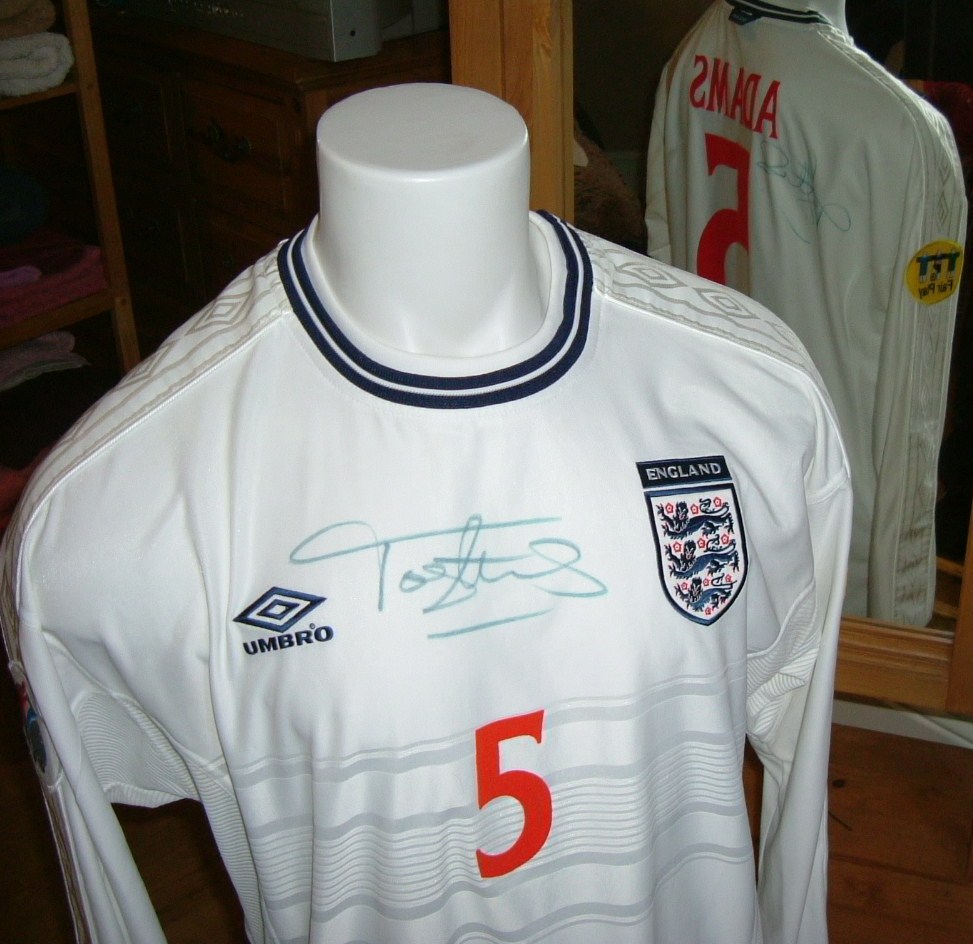 |
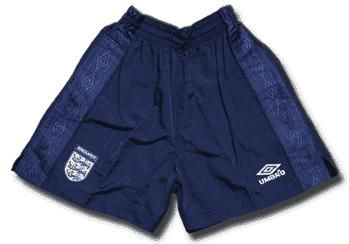 |
 |
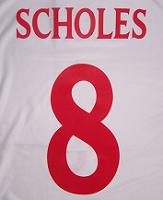 |
|
White short-sleeved shirt,
with a rectangular panel of horizontal shadow pin-stripes across the
chest. Upper and lower edges bounded by an outer thin stripe and an
inner thick stripe. Centre of panel contains eight thin stripes bounded
by a thick stripe at the top and bottom. Two navy-blue stripes around
crew-neck collar and cuffs. Repeating pattern of two shadow concentric diamonds, bounded by two
shadow stripes at each side,
running from the neck to the cuffs on a raised panel, down each shoulder and outer sleeve. Microfibre breathable panel down each side of shirt covering underarm
and inner sleeve. Embroidered emblem on left breast, with 'ENGLAND' in
capitalised white lettering inside a navy-blue panel above the emblem.
Two embroidered navy-blue concentric diamonds on right breast, with 'UMBRO'
in capitalised navy-blue lettering underneath and a registered trademark
placed above the gap between the 'R' and the 'O' in navy blue. Red
number on back and in centre of chest over upper two-thirds of shadow
chest-stripe panel, in a new font.
Navy-blue shorts, with navy-blue drawstring. Repeating pattern of two shadow concentric
diamonds, bounded by two shadow stripes at each side, running
down a raised panel on each seam, including the waistband. Two embroidered white concentric diamonds on left thigh,
with 'UMBRO' in capitalised white lettering underneath and a registered
trademark placed above the gap between the 'R' and the 'O' in white.
White number, in the same font as on the shirt, above the Umbro logo on
left thigh. Embroidered emblem on right thigh, with 'ENGLAND' in
capitalised white lettering inside a navy-blue panel above the emblem.
White socks. 'UMBRO' in large capitalised navy-blue lettering
across turnovers edged with navy-blue hoop and along right side of
footing.
David Beckham became the first England captain to wear the Three Lions
emblem on an armband when he led the team out against Italy on this
shirt's last appearance, in 2000. The rest of the armband was red. |
|
Variations |
- A long-sleeved
version of the shirt was also worn.
The cuffs were navy blue, with
a white stripe near the edge. It was worn by the majority of the team in the
games in Hungary and Italy, and in both legs against Scotland. In Finland,
there was an equal number in short and long sleeves. For
each of the other games, the short-sleeved version was worn by the most
players.
- For the two games
played in the 2000 European Championship final tournament, the player's
surname was worn above the number on the back, in capitalised plain red
lettering in a new font (pink characters were unused, with
the letter F only appearing on the shirt of Robbie Fowler, who was an unused
substitute in both games). The shirts worn by the Neville
brothers also included their first initial i.e. G . NEVILLE and P . NEVILLE
(with a space either side of the full stop).
.jpg)
- England had logos
sewn onto the upper sleeves for the 2000 European Championship tournament
fixtures. The 'Euro 2000' tournament logo was on the right arm and the same UEFA
Fair Play logo as for 'Euro '96' was on the left arm.
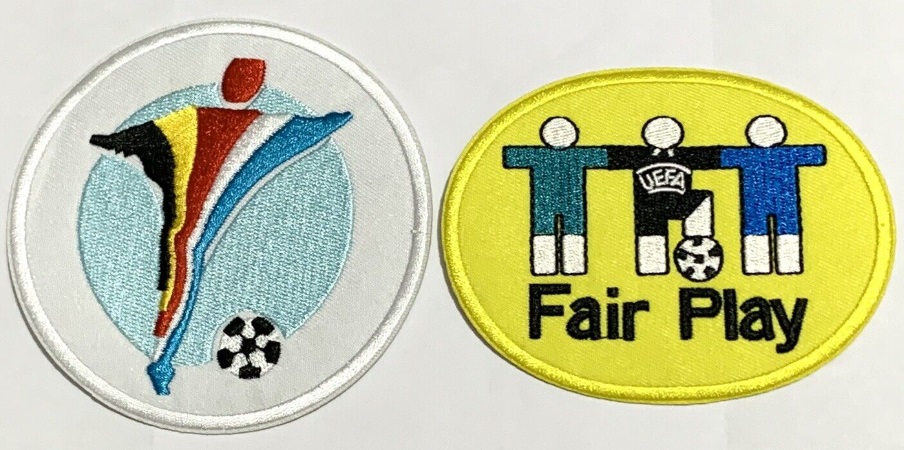
|
|
Most Appearances |
10 -
Phil Neville (2 sub)
9 - David Beckham, Martin
Keown (1 sub), Alan Shearer
-
Eight players won their
first cap in this shirt, including Emile Heskey, who notched up 62
England appearances.
-
Eight players also made their
last international appearance in this shirt.
-
Stuart Pearce collected his
78th cap at the end of an illustrious career, whilst Alan Shearer bowed
out at Euro 2000, with his 63rd cap.
-
Michael Gray won just three
England caps, the first and last of which were in this shirt.
-
Seth Johnson's entire
international career of 17 minutes, in Turin, was spent in this shirt.
|
|
Top Scorers |
6 -
Alan Shearer (2 Pens.)
4 - Steve McManaman, Michael
Owen, Paul Scholes
-
This was the third home
shirt in succession that Shearer had been top scorer in. He signed off
with a penalty in his last game, which unfortunately saw England's early
exit from Euro 2000. It was his thirtieth for his country.
-
Only Heskey scored his first
international goal in this shirt, his first of seven.
-
Apart from Shearer, Keown
was the only player to notch his last England goal in the shirt, his
second coming in the same game (against Malta) in which Heskey scored
his first.
|
|
Captains |
9 - Alan
Shearer
1 - Tony
Adams, David Beckham, Martin Keown
-
Shearer was an ever-present
captain throughout Kevin Keegan's time in charge, until his retirement
from international football at the end of the 2000 European Championship
finals tournament.
-
The three remaining games
played in this shirt were each under a different coach. Keegan
reinstated Adams as skipper on Shearer's retirement, only for Adams to
also retire from international football.
-
Howard Wilkinson took over
and selected Keown for his only outing as captain, before Peter Taylor
unexpectedly turned to Beckham, for his single game in charge, on the
shirt's last outing.
-
Beckham went on to captain
his country on 59 occasions.
|
|
|
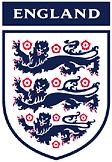
 After the excesses of the nineties, England came
up trumps with a return to a more traditional style of kit, though all was not
as it appeared. After the excesses of the nineties, England came
up trumps with a return to a more traditional style of kit, though all was not
as it appeared.
The shirt returned to plain white, simple
yet attractive, and more akin to a classic sixties style, with discreet navy
blue stripes on the collars and cuffs. However, Umbro cleverly managed to sneak
their own traditional diamond pattern onto both the sleeves and the seams of the
shorts. As these were the same colour as the shirts and shorts, they were only
visible when up close. If they had been in contrasting colours, there would
surely have been outrage amongst England fans.
Umbro sensibly dispensed with the large capitalised
letters above the three-lions emblem, a practice that had begun with the
1995 home white
shirt. The team name, England, which had appeared below the emblem
in the middle of recent jerseys--probably to dispel the impression created by
the prominence of the manufacturer's name that the shirt was the Umbro team's
jersey--was now imprinted on a navy blue strip
across the top of the emblem. Since the three-lions emblem was so
well known and synonymous with England and since England had done without the
team name on their shirts for most of their history, it was a wonder why this
embellishment was necessary.
There were other changes in the three-lions emblem. It
returned to the traditional left side of the shirt. The
designers reverted to the traditional navy blue as the colour of the three lions. And the white margin surrounding the three lions, a feature which began with
the
1993 home white shirt, was omitted in favour of the traditional design,
brought back on the instructions of the FA's Executive Director, David Davies.
Umbro claimed to have produced a shirt that was as space-age as any
produced by NASA over the years, with Microfibre material, not to mention a
Vapatech coating on the shirt.
Thanks to Kevin Keegan's desire to use the
red kit for every
colour clash, it was only seen at Wembley on two occasions out of twelve games
and it was a desperate period in England's history. Keegan guided them into the
European Championship finals tournament, though they needed Sweden's help in
beating Poland, so that they could secure a play-off place, where a miserable
Wembley performance against Scotland saw them limp over the finishing line with
an embarrassing defeat. This was further compounded in the final tournament when
England twice threw away winning positions to leave early with their tails
between their legs. It took Keegan another four months to fall on his sword.
The new millennium had begun in complete disarray
for England. Following Keegan's departure, there were two more temporary
coaches appointed in Messrs. Wilkinson and Taylor, but it was a further four
months before a permanent replacement could take charge, by which time the new
cycle of an Umbro kit launch every year had begun and would continue until
the end of the decade, whereupon the cycle was speeded up. |
|
Matches in which England wore the
1999 Home White Uniform |
|
760 |
4
September 1999 -
England
6
Luxembourg 0 [5-0]
Wembley Stadium, Wembley, London (68,772) |
Shearer (3
(1 pen)),
McManaman (2),
Owen |
HW |
|
761 |
8 September 1999
-
Poland
0 England 0
[0-0]
Stadion
Wojska Polskiego, Śródmieście,
Warszawa (17,000) |
|
AD |
|
European Championship preliminary play-offs |
|
763 |
13
November 1999 -
Scotland
0 England 2
[0-2]
The National Stadium, Hampden Park, Glasgow (50,132) |
Scholes (2) |
AW |
|
764 |
17 November 1999 - England 0
Scotland
1 [0-1]
Wembley Stadium, Wembley, London (75,848) |
Hutchison |
HL |
|
Friendly match |
|
768 |
3
June 2000 -
Malta
1
England 2
[1-0]
Grawnd Nazzjonali, Ta' Qali (10,023) |
Wright OG
Keown, Heskey |
AW |
|
European Championship Finals in Belgium and
Netherlands |
|
769 |
12
June 2000 -
Portugal
3
England
2 [2-2]
Philips Stadion, Philipsdorp, Eindhoven (31,500) |
Figo, Pinto, Gomes
Scholes, McManaman |
NL |
|
771 |
20
June 2000 -
England
2
Romania 3 [2-1]
Stade du Pays, Neuville, Charleroi (30,000) |
Shearer (pen), Owen
Chivu, Munteanu, Ganea (pen) |
NL |
Players wearing both sleeve lengths in
the same match are counted once in each column. Playing substitutes and
those substituted each count as one. Players wearing different shirts
with the same sleeve length in the same match only count as one (though
it would appear that they only had one available in each length to choose
from).
It was also worn on
the bench by unused substitutes,
Michael Ball, Francis Jeffers and Frank Lampard (v.
Hungary), Steve Froggatt and Trevor Sinclair (v. Scotland
at Hampden), Steve Guppy (v. Scotland at Wembley), Steven
Gerrard (at Euro 2000), Alan Smith (v. France), Joe Cole
(v. Finland), and Ball and Lampard again (v. Italy).
The
Under-16 and Under-18 teams (soon to be transformed into
Under-17 and Under-19) wore the same design, except that
each wore an embroidered scroll below the emblem, within which
YOUTH was displayed, in navy blue (though, seemingly, not in
every match).
Meanwhile, the Under-15 team (which had been inherited from
the English Schools' Football Association, and would soon become the FA's
under-16 team) continued to wear adidas kits that had previously been
earmarked for schoolboy internationals, with Walkers as shirt sponsors, but
with the FA's emblem on the chest, rather than the ESFA's. At the beginning
of the 2000-01 season, they switched to the FA's Umbro kits, but retained
Walkers as shirt sponsor.
England's Under-21,
Semi-Professional and women's teams also wore the same design,
without the scrolls. All levels now included numbers on the
front of the shirts and on the shorts (though the women's kit may have only
included them for UEFA European Championship qualifiers).
In the
three fixtures at the 2000 UEFA Under-21 Championship in Slovakia, the
player's surname was worn above the number on the back of the shirt, for the
first time for the Under-21s. It was the same red font used for the Euro
2000 tournament, later that month (all characters were used, except Q, V, X
and Z, with no small 'c' or full stops). England wore the tournament
logo (below) on the right arm and the same UEFA Fair Play logo worn at Euro
2000 (see above) on the left arm.
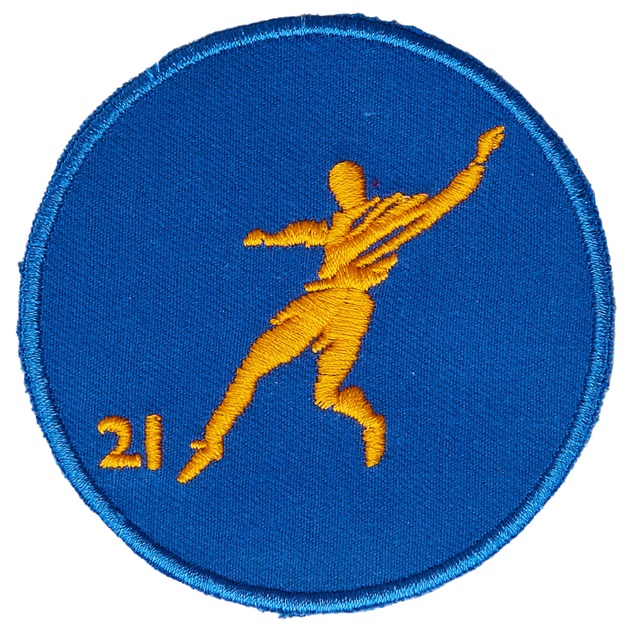
|
England's Record wearing the 1999 Home
Shirt |
|
Type |
P |
W |
D |
L |
F |
A |
GD |
FTS
|
CS |
FAv |
AAv |
Pts % |
W/L |
|
Home |
2 |
1 |
0 |
1 |
6 |
1 |
+5 |
1 |
1 |
6.00 |
1.00 |
50.0 |
=0 |
|
Away |
8 |
2 |
5 |
1 |
7 |
5 |
+2 |
3 |
3 |
0.875 |
0.625 |
56.3 |
+1 |
|
Neutral |
2 |
0 |
0 |
2 |
4 |
6 |
-2 |
0 |
0 |
2.00 |
3.00 |
00.0 |
-2 |
|
Total |
12 |
3 |
5 |
4 |
17 |
12 |
+5 |
4 |
4 |
1.417 |
1.00 |
45.8 |
-1 |
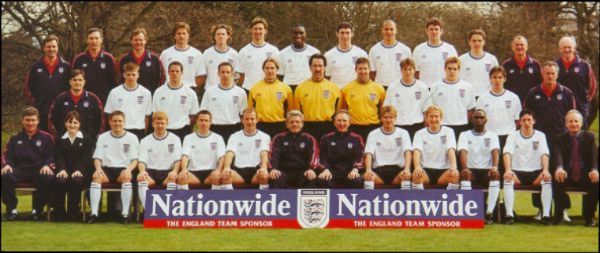
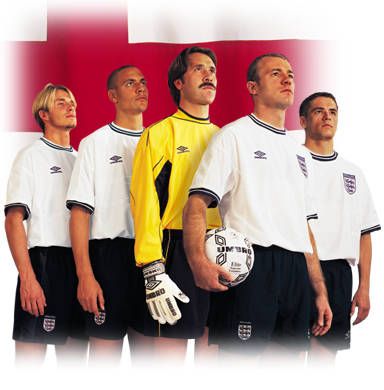
____________________
JB/PY/CG/GI
|
|